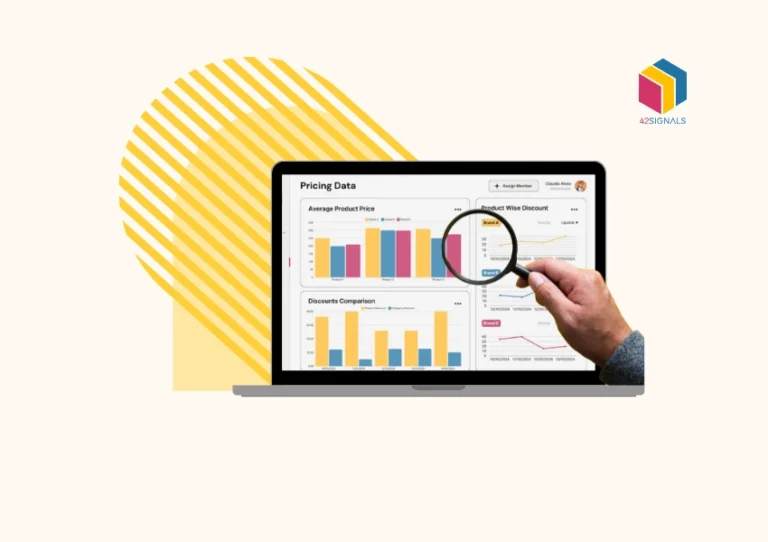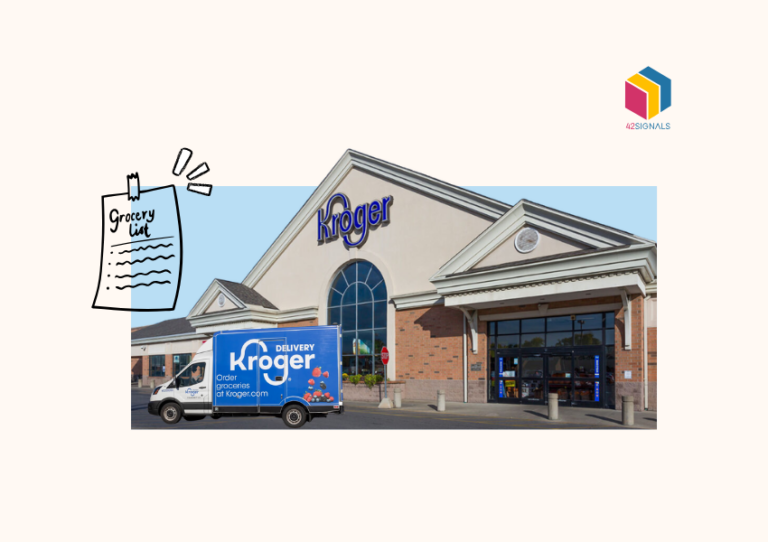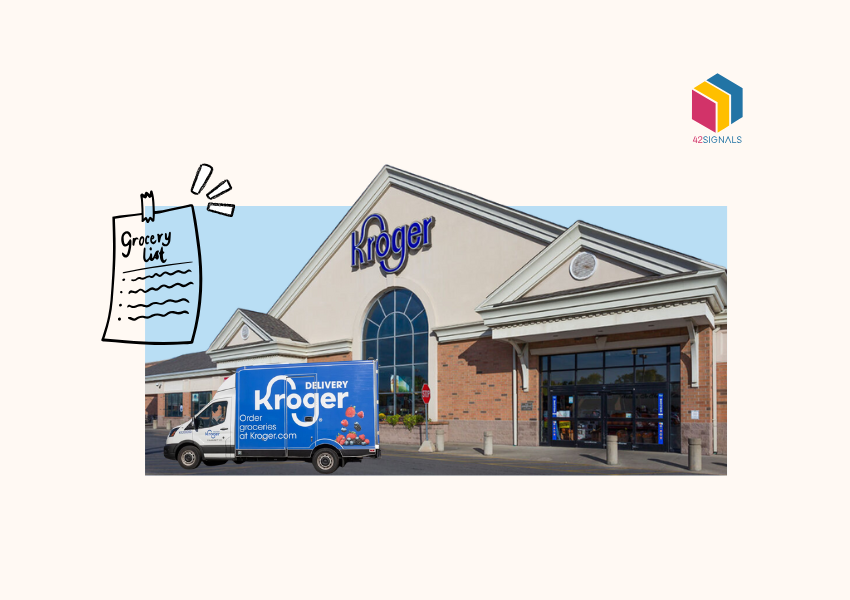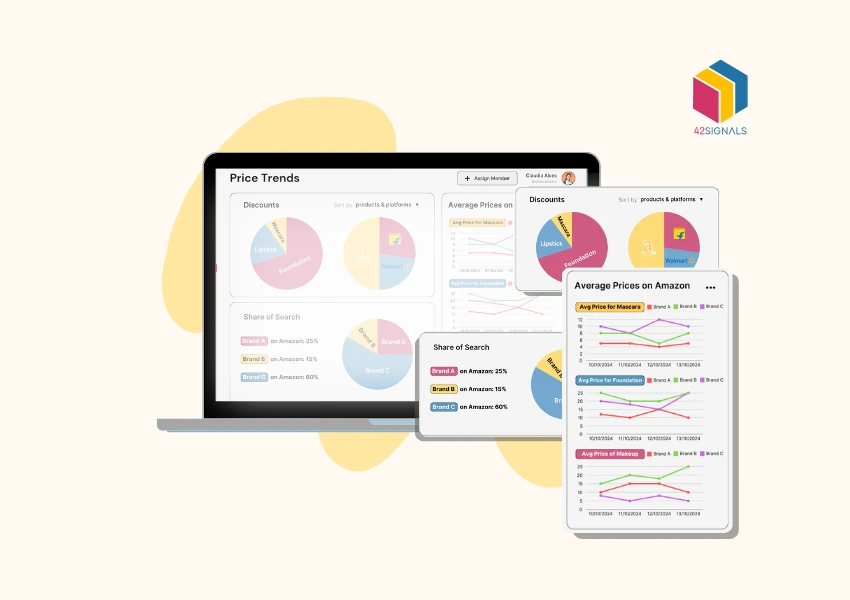Picture this: You own an online store that sells electronics. One day, you notice a sharp decline in sales. Confused, you check a competitor’s website and realize they’ve dropped their prices overnight—and you had no idea. By the time you manually update your prices, you’ve already lost dozens of potential customers. This is exactly why businesses need to scrape prices effectively and stay ahead of rapid market shifts.
A study by McKinsey found that companies implementing dynamic pricing strategies see revenue increases of 2-5% and profit margin improvements of up to 10%. This indicates that real-time competitor price tracking is no longer an option but a requirement.
However, tracking competitor prices manually is not a practical solution. Due to stock availability, demand shifts, and rapid adjustments from competitors’ prices, changes occur multiple times throughout the day. All these factors combined result in inefficient, error-prone processes. The fast-paced nature of these conditions can only be solved using automated price monitoring, and web scraping.
Collecting accurate pricing data isn’t an easy task. This guide is designed to provide you with the legal considerations around price scraping, the tools to help you do so, a step-by-step process to collect accurate pricing data efficiently, and of course, the fundamentals needed to operate efficiently.
What is Competitive Price Tracking and Why Does It Matter?
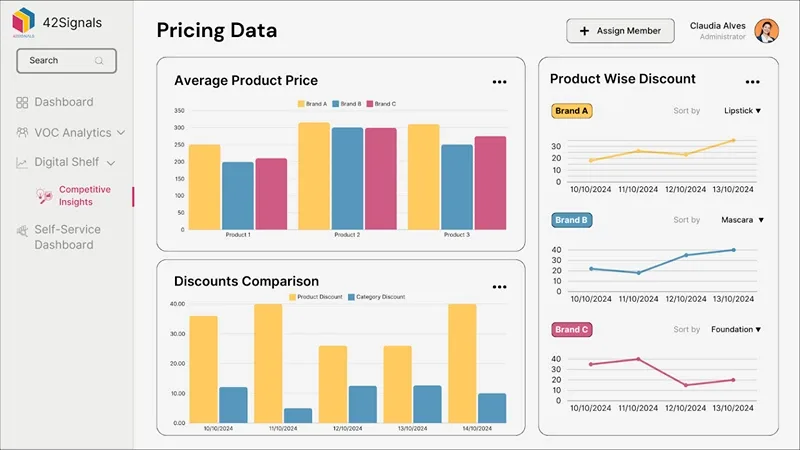
Competitive price tracking is the practice of continually monitoring prices among competitors in order to make strategic pricing decisions. Businesses need this information to make changes to their prices, improve competition, and increase revenue. This process is critical in sectors with volatile pricing, such as electronics, fashion, and consumer goods.
By monitoring prices in real-time, businesses can guarantee that they are not pricing themselves too high (thereby losing customers) or pricing themselves too low (cutting into profits unnecessarily). The strategies formulated around price tracking help companies articulate the range within which there is a balance between the sales volume and profit margin obtained.
Why Businesses Need Competitive Price Tracking
1. Maintaining Profitability While Staying Competitive
If your competitors are frequently changing their prices and you are not aware of these changes, then blindly following pricing trends without informed analyses may price you out of the market. Without proper analysis beforehand, setting prices too low simply equals giving away profits. When one is armed with accurate data, decision-making is streamlined. Price tracking allows businesses to respond to their competitors intelligently rather than reactively.
2. Understanding Pricing Trends and Seasonal Changes
Pricing responds to changes in demand, promotional activity, and seasonal shifts. For example, boosts in sales tend to result from steep discounts offered during the holidays. As a consequence, if you stay unaware or unresponsive to conditions where your pricing is too high, you will lose sales. Monitoring prices over time helps businesses plan for recurring seasonal shifts.
3. Enhancing Customer Trust with Consistent Pricing
Nowadays, customers are highly price sensitive. If they see prices that are far too inconsistent or always higher than the competition, most likely they will not purchase. Tracking prices ensures that your competitors are selling at the expected average where customers expect, thus increasing customer trust and brand loyalty.
4. Reacting Quickly to Market Changes
Changes in market conditions happen rapidly within the e-commerce market. The competition is known to adjust pricing up to three to four times every single day. If you do not adapt your strategy within this competitive landscape, it creates the possibility of losing out to lower sales or profit opportunities during increased demand. The good news is price scraping enables monitoring of real-time changes.
How Web Scraping Powers Competitive Price Tracking
Web scraping is a term that refers to an automated technique that collects information from websites. For price tracking, scraping enables a business to automate data collection of competitors’ pricing details. Businesses no longer need to continuously visit competitors’ websites to check for changes.

How Price Scraping Works
1. Crawling Websites for Price Data
The operation of a web scraper is similar to that of a crawler in a search engine. It scans web pages with the intention of searching for relevant pricing information like current prices, discounts, and product availability. Such crawlers are programmed to capture structured data.
2. Extracting and Structuring the Data
The web scrapers after locating the associated details and information with the price data, capture them and put them in order which could be in Excel spreadsheets, files or databases, and even APIs. Structured data makes it easier for businesses to analyze pricing trends.
3. Automating Data Collection
To save time and energy, businesses do not have to visit each competitor’s website. Instead, businesses can set schedule scraping sessions to scrape prices at intervals. This assures that data is collected regularly and all price information is reliable. Now businesses can compete at a different level.
4. Leveraging Digital Shelf Analytics
Once price data is collected, businesses use e-commerce analytics tools to compare pricing trends, track competitor strategies, and adjust their prices accordingly. This data-driven approach ensures that pricing decisions are based on real-time insights rather than guesswork.
Legal and Ethical Considerations When Scraping Prices
Is It Legal To Scrape Prices?
The legality of whether or not to scrape prices depends on factors such as where the data is being obtained, if it has been put in the terms of the site being used, and if the data protection policies are being followed. Generally, extracting publicly available pricing information is legal, but scraping data behind login walls or violating a website’s terms of service could result in legal risks.
Best Practices for Ethical Price Scraping
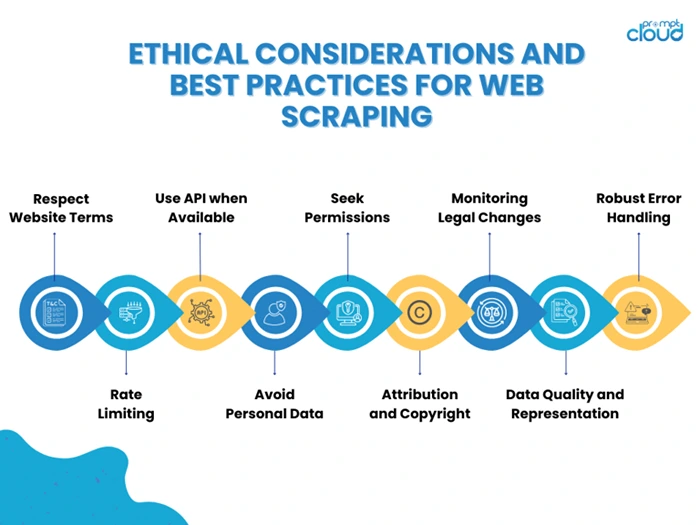
Image Source: PromptCloud
1. Follow Robots.txt Guidelines
Every site has its own rules governing accepting removal of information being done through the use of programs as automated website guides. That file tells robots what data they seek to collect. Prior to scraping prices, a business is required to look into this document to verify the needed laws are not violated.
2. Avoid Excessive Requests That Could Crash a Website
Sending too many requests in a short period can overload a website’s server, leading to IP bans or legal actions. To prevent this, scrapers should space out requests and mimic human browsing behavior.
3. Scrape Only Publicly Available Data
Collecting personal or sensitive data without permission can violate data privacy laws like GDPR. Businesses should only scrape pricing information that is openly accessible to the public.
4. Respect Copyright and Intellectual Property Laws
Certain websites have restrictions that disallow data scraping. A business undergoing such scraping is bound to face ramifications. Always read the terms of service before going forward with any activities on the website.
How to Set Up a Price Scraping System for Your Business

Now that we understand the importance of competitive price tracking, let’s dive into how to set up a price scraping system and scrape prices. A well-structured system ensures that data collection is accurate, efficient, and actionable.
Step 1: Define Your Pricing Goals
Before you scrape prices, determine your business objectives. Do you want to align with competitor prices, find market seasonality, or increase your profit margin? You need to think clearly to draw a precise data collection plan.
For instance, if you own an electronics online shop, tracking daily price changes of highly sought-after items such as smartphones would be beneficial. As a retail store, you could monitor discounting trends among significant competitors to refine business promotional strategies.
Step 2: Identify Competitor Websites
Make a list of the competitor websites you want to monitor. Select both direct competitors in your market as well as leading businesses from the industries to capture wider pricing strategies.
Make sure to analyze:
- Specific categories of products that relate to your business
- How often do price changes happen on competitor websites
- Whether there are offers, discounts, bundles, or if the competitor has a dynamic pricing strategy
Step 3: Choose the Right Web Scraping Tool
Every business is different when it comes to data collection. Some require real-time monitoring, while others can operate on a weekly refresh.
- For small businesses: No-code solutions like Octoparse or ParseHub can be good options.
- For larger businesses: Advanced platforms like 42Signals offer deeper e-commerce analytics and insights.
- For developers: Open-source frameworks like Scrapy allow for full customization.
Step 4: Extract and Store Pricing Data
Once your scraper is running, make sure the collected price data is structured and stored properly. Businesses often keep scraped prices in structured Excel files, databases, and cloud services for long-term trend analysis.
Step 5: Use Data to Make Pricing Decisions
Once you’ve collected data, don’t let it go to waste. Use competitive price tracking insights to:
- Adjust your prices dynamically to stay competitive
- Identify pricing trends and forecast future changes
- Optimize promotional strategies based on competitor discounts
By setting up a well-structured price scraping system, businesses can monitor market trends and make data-driven pricing decisions efficiently.
Best Tools for Scraping Prices Like A Pro
Choosing the right e-commerce price scraping tools depends on factors like budget, technical expertise, and data volume. Here are some of the best options:
1. 42Signals
42Signals provides advanced competitive price tracking and digital shelf analytics, allowing businesses to monitor real-time pricing trends and optimize their strategies accordingly.
2. Scrapy
Scrapy is an open-source web scraping framework that is fully tailored to the needs of its users who are looking for unique and flexible approaches to obtaining data.
3. Octoparse
This is a DIY web scraping software that allows users to scrape prices from their competitors without involving themselves in complicated programming procedures.
4. ParseHub
With the help of ParseHub, a business can point and click on the web pages of e-commerce sites and retrieve the price data they want to capture.
5. DataMiner
DataMiner is a helpful Chrome extension that enables the fast extraction of pricing information from a plethora of websites without the hassle of developing advanced algorithms.
PromptCloud’s Fully Managed Web Scraping Services
For businesses needing accurate pricing data without the hassle, PromptCloud’s fully managed web scraping services deliver clean, structured data from multiple e-commerce sites. This ensures reliable insights without dealing with scraper maintenance.
When combined with 42Signals’ competitive price tracking and digital shelf analytics, businesses can collect, analyze, and act on pricing data more effectively—staying ahead in a fast-moving market.
Challenges of Price Scraping and How to Overcome Them
Despite price scraping providing great levels of business intelligence, it does come with challenges. Knowing problems helps companies develop better scraping solutions.
1. Websites Blocking Scrapers
Numerous e-commerce websites detect and block web scrapers using CAPTCHAs or IP bans. If a scraper sends too many requests at once, the website may flag it as a bot and deny access.
How to overcome it:
- Use rotating IPs, distributing requests between various proxies and locations.ns.
- Implement human-like delays between requests to avoid detection.
- Use headless browsers like Puppeteer to simulate real user behavior.
2. Frequent Website Layout Changes
E-commerce sites frequently update their website structure, which can break a scraper’s ability to extract price data correctly.
How to overcome it:
- Regularly monitor and update scrapers to adapt to changes.
- Use machine learning models that detect changes in webpage structure.
- Leverage e-commerce price scraping tools like 42Signals, which update automatically.
3. Managing Large Volumes of Data
When businesses are monitoring hundreds or even thousands of products, working with large datasets can become overwhelming. Storing, analyzing, and extracting insights from vast amounts of pricing data requires efficient data management strategies.
How to overcome it:
- Implement cloud storage with Google Cloud, AWS, or Azure.
- Make use of automated data pipelines that provide real-time data cleaning and processing.
- Utilize digital shelf analytics that capture and showcase trends in prices.
4. Legal and Compliance Issues
Web scraping is prohibited in the terms of use for certain sites. Furthermore, data privacy laws such as GDPR add additional complexities concerning the collection of data.
How to overcome it:
- Ensure that only freely available public pricing data is scraped (steer clear of login or personal data).
- Get in touch with legal professionals before initiating scraping processes at a larger scale.
- Adopt legally and ethically compliant methods of competitively tracking prices to guarantee sustainability.
Addressing these issues allows for the development of an automated and legally compliant price tracking system that drives business value.
Why Businesses Need Automated Price Scraping
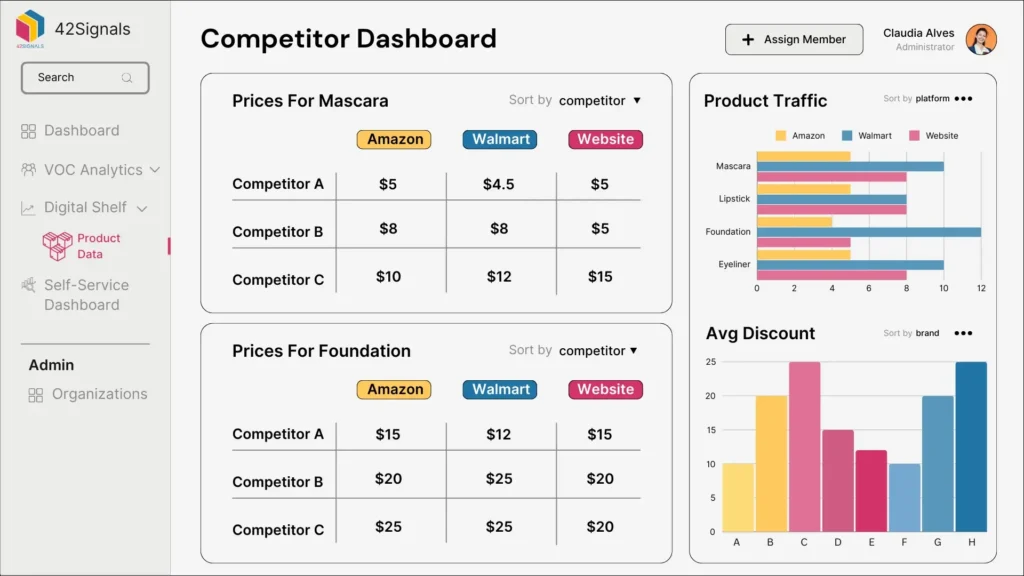
Monitoring prices has turned into a business requirement. Businesses that do not adjust their pricing for products risk losing customers, and market opportunities, and falling behind on trends.
Through e-commerce price scraping tools like 42Signals, businesses are now able to scrape prices, automate price tracking, acquire critical information, and make real-time adjustments to their pricing structure. From small business owners to pricing analysts and e-commerce managers, web scraping for price monitoring can give you an edge in one of the most competitive markets.It’s time to enhance your pricing strategies, start with automated price tracking for monitoring competitor prices now! Sign up to 42Signals.
